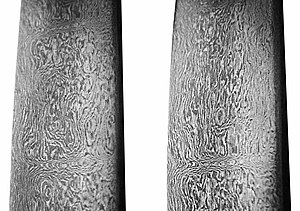
Back فولاذ دمشقي Arabic Acer de Damasc Catalan Damascénská ocel Czech Damascering Danish Damaszener Stahl German Damaska ŝtalo Esperanto Acero de Damasco Spanish Damaskuse teras Estonian Damaskoko altzairu Basque فولاد دمشق Persian

Damascus steel (Arabic: فولاذ دمشقي) is the forged steel of the blades of swords smithed in the Near East from ingots of carbon steel imported from Southern India or made in production centers in Sri Lanka[1] or Khorasan, Iran.[2] These swords are characterized by distinctive patterns of banding and mottling reminiscent of flowing water, sometimes in a "ladder" or "rose" pattern. Such blades were reputed to be tough, resistant to shattering, and capable of being honed to a sharp, resilient edge.[3]
Wootz (Indian), Pulad (Persian), Fuladh (Arabic), Bulat (Russian), and Bintie (Chinese) are all names for historical ultra-high carbon crucible steel typified by carbide segregation. "Wootz" is an erroneous transliteration of "utsa" or "fountain" in Sanskrit; however, since 1794, it has been the primary word used to refer to historical hypereutectoid crucible steel.[4] The term "Damascus steel" itself likely traces its roots to the medieval city of Damascus, Syria.
- ^ The Sword and the Crucible: A History of the Metallurgy of European Swords Up to the 16th Century, Alan R. Williams (2012). The Sword and the Crucible. Brill. p. 30. ISBN 9789004227835.
{{cite book}}: CS1 maint: numeric names: authors list (link) - ^ Bronson, Bennet (1986). "The making and selling of wootz, a crucible steel of India". Archeomaterials. 1: 1. S2CID 111606783.
- ^ Figiel, Leo S. (1991). On Damascus Steel. Atlantis Arts Press. pp. 10–11. ISBN 978-0-9628711-0-8.
- ^ Dube, R. K. (2014-11-01). "Wootz: Erroneous Transliteration of Sanskrit "Utsa" used for Indian Crucible Steel". JOM. 66 (11): 2390–2396. doi:10.1007/s11837-014-1154-1. ISSN 1543-1851. S2CID 110149977.
© MMXXIII Rich X Search. We shall prevail. All rights reserved. Rich X Search